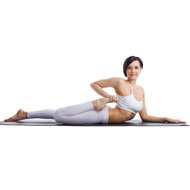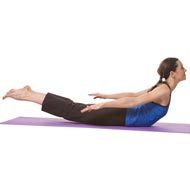Half Frog Pose - Ardha Bhekasana
The Half Frog Pose (Ardha Bhekasana) is a pose is one of the most difficult and challenging yoga poses. This pose has many variations and this is why it is also known as Mandukasana.
When practiced, this pose resembles a frog, hence the name given to this yoga pose. The Half Frog Pose is an intermediate level pose and can be changed to suit the level of the person practicing it.
Steps :
- Lie flat on your stomach.
- Press your arms onto the floor.
- Now raise your torso and your head.
- Bnd the right knee while moving the heel towards the right buttock. Move your right hand back and hold your foot. Your palms should press against the top of your foot. Your fingers should point in the same direction as your toes are.
- Turn your elbow so that it is facing the ceiling.
- Now press your foot towards your buttock – as far as possible and as comfortable as you can manage to be while doing this. If you feel any pain in the knee or hip while doing this, reduce the amount of weight you are placing on your foot.
- Adjust your shoulders and keep them even. Instead of supporting yourself on your hand, you can use your forearm and elbow to support your self.
- Hold this position for about a minute or at least five deep breaths. Release your foot and then repeat the above steps with the left foot.
Precautions :
- Avoide the pose if you have any neck, shoulder or lower back injuries.
- People who suffer from migraine, high blood pressure, insomnia should avoid practicing this pose.
- As with all yoga poses, it is essential that you get your doctor's approval before you attempt to do this pose.
Beginner's Tip :
Beginners to yoga might find this a difficult pose to practice and should keep this beginner's tip for Half Frog Pose in mind. Using a bolster while practicing this pose can help a beginner to get the flexibility and strength that is needed to perform this pose. The bolster should be placed under the beginner's lower ribs as this will help him/her to lift the upper body better. The beginner's free arm should be pressed onto the floor in front of this prop.
Benefit To Body Part :
- This pose is beneficial for the back as it strengthens the muscles of the back. It helps to improve posture as well.
- It stretches the hips and the quadriceps.
- It is a very good pose for rejuvenating the knee joints as the psoas muscles and quadriceps are stretched in this pose.
- It improves digestion by stimulating the abdominal organs.
- This pose stretches the entire front and back of the body and strengthens the joints and muscles throughout the body.
- It stretches the throat, chest and abdomen, groin, thighs and ankles.
Therapeutic Applications :
- It is of particular benefit for those who suffer from either fallen arches or flat feet as the pose can stretch and strengthen these problem areas.
- The Half Frog pose is an energizing pose and helps to open the chest and heart. This in turn leads to an increase in blood flow and fuller breaths.
- It also increases the flow of blood to the uterus and the ovaries.
Variations :
- Cobra Pose (Bhujangasana)
Preparatory Poses :
- Cobra Pose (Bhujangasana)
- Reclining Hero Pose (Supta Virasana)
- Hero Pose (Virasana)
Follow Up Poses :
- Downward Facing Dog (Adho Mukha Svanasana)
- Eagle Pose (Garudasana) (arms only)



